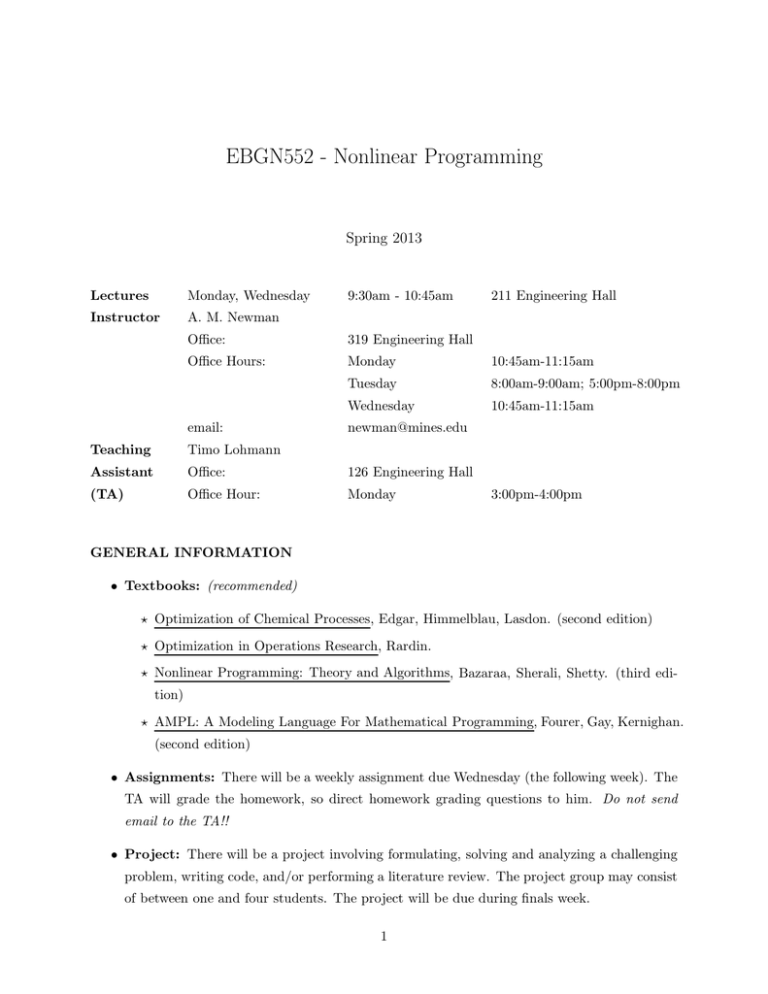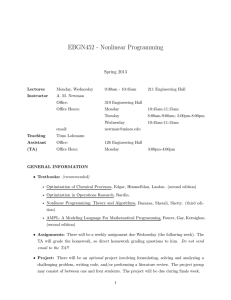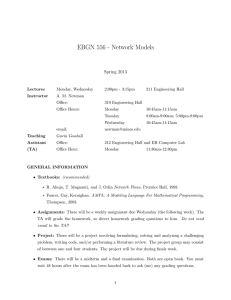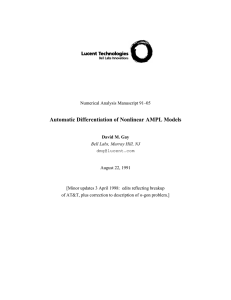EBGN552 - Nonlinear Programming Spring 2013
advertisement

EBGN552 - Nonlinear Programming Spring 2013 Lectures Monday, Wednesday Instructor A. M. Newman 9:30am - 10:45am 211 Engineering Hall Office: 319 Engineering Hall Office Hours: Monday 10:45am-11:15am Tuesday 8:00am-9:00am; 5:00pm-8:00pm Wednesday 10:45am-11:15am email: newman@mines.edu Teaching Timo Lohmann Assistant Office: 126 Engineering Hall (TA) Office Hour: Monday 3:00pm-4:00pm GENERAL INFORMATION • Textbooks: (recommended) ⋆ Optimization of Chemical Processes, Edgar, Himmelblau, Lasdon. (second edition) ⋆ Optimization in Operations Research, Rardin. ⋆ Nonlinear Programming: Theory and Algorithms, Bazaraa, Sherali, Shetty. (third edition) ⋆ AMPL: A Modeling Language For Mathematical Programming, Fourer, Gay, Kernighan. (second edition) • Assignments: There will be a weekly assignment due Wednesday (the following week). The TA will grade the homework, so direct homework grading questions to him. Do not send email to the TA!! • Project: There will be a project involving formulating, solving and analyzing a challenging problem, writing code, and/or performing a literature review. The project group may consist of between one and four students. The project will be due during finals week. 1 • Exams: There will be a midterm and a final examination. Both are open book. You must wait 48 hours after the exam has been handed back to ask (me) any grading questions. • Grading: ⋆ Class Participation: 5% ⋆ Homework Assignments: 20% ⋆ Project: 25% ⋆ Midterm: 20% ⋆ Final: 30% Grading is done on a curve where 90% is sufficient but not necessarily necessary for an A-, 80% is sufficient but not necessarily necessary for a B-, etc. COURSE OUTLINE ⋆ I. Nonlinear Programming Formulations · Unconstrained problems · Constrained problems ⋆ II. Mathematical Structure of Nonlinear Programs · Review of linear programming · Difficulty of finding solutions for nonlinear programs · Well-behaved nonlinear programs (convex sets, convex functions, convex regions) ⋆ III. Solution Techniques for Unconstrained Problems · Optimality conditions · Rate of convergence · Steepest Descent and Line search · Newton’s method ⋆ IV. Solution Techniques for Constrained Problems · Karush-Kuhn-Tucker optimality conditions · Lagrangian methods · Penalty and Barrier methods · Methods of feasible directions, e.g., reduced gradient ⋆ (V. Mixed Integer Nonlinear Programming)1 1 Time permitting 2 · Formulation · Solution techniques ⋆ Computer Implementation · Model implementation will be emphasized throughout the course (using AMPL or GAMS as a modeling language – as in EBGN555, 556, and 557). However, as time permits, we will explore how to “fine-tune” state-of-the-art software (e.g., MINOS) to achieve the “best” results (in terms of solution quality or solution time) possible. • RULES ⋆ Please do not send email regarding homework problems; come to office hours instead. ⋆ Statute of limitations for questions about grading is one week from the student’s receipt of the graded work. ⋆ I do not want to see or hear your cell phone. Ever. This includes during office hours. ⋆ No rudeness of any kind towards anyone in the class will be tolerated. ⋆ Do not talk to your neighbor during class. ⋆ You may confer with others regarding the homework and project, but the work you hand in must be your own. Please ensure it is done neatly. ⋆ Attendance in class is required. Be on time. ⋆ Any alternate arrangements for exams must be submitted in writing at least one week in advance of the exam. Any additional arrangements regarding disabilities must be formally and legally documented and approved. A minor infraction of the above rules will result in a warning. A major infraction will result in expulsion from the class. 3









